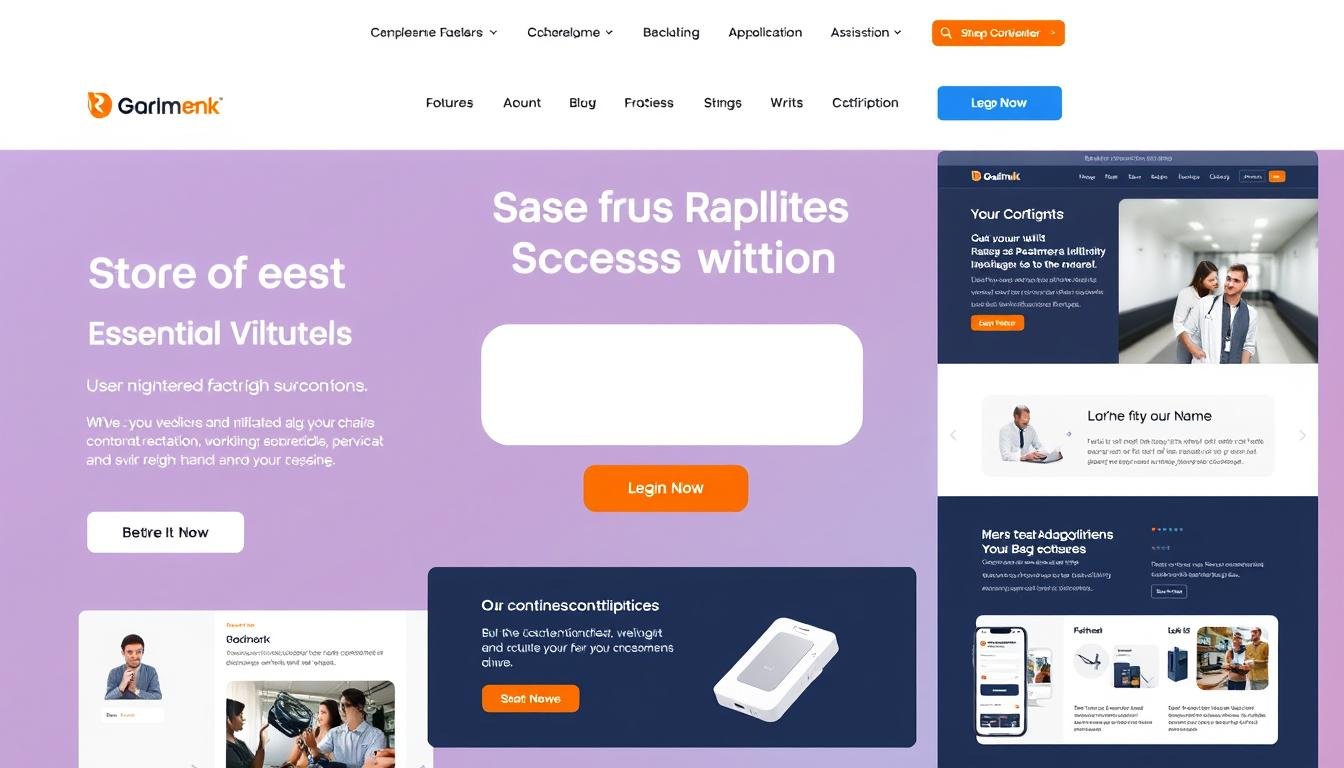Did you know that a staggering 50% of users will abandon a website if they encounter a poor user experience? Effective web design is not just about aesthetics but also about optimizing functionality and usability. Websites with high bounce rates, low time on site, and low conversions are often the result of subpar design principles.
In this comprehensive article, we’ll explore the top 10 timeless web design principles that can transform your online presence and drive business success. From responsive layouts and visual hierarchy to typography and color theory, these fundamental guidelines will help you create a website that resonates with your audience and drives measurable results.
Key Takeaways
- Effective web design goes beyond just aesthetics, it’s about optimizing functionality and usability.
- Websites with poor design often suffer from high bounce rates, low time on site, and low conversions.
- Implementing timeless web design principles can significantly improve user experience and drive business success.
- Key principles include responsive layout, visual hierarchy, typography, color theory, and more.
- Staying up-to-date with the latest web design best practices is crucial for maintaining a competitive edge.
Defining Good Web Design
Exceptional web design is not merely about aesthetics; it’s a strategic approach that aligns with your business goals and user needs. By embracing the principles of effective web design, you can create a user-friendly, visually appealing, and high-performing online presence that drives business success.
Principles of Effective Web Design
The cornerstone of good web design is a deep understanding of your target audience. Crafting a website that resonates with your users’ preferences, behaviors, and pain points is crucial. Renowned designer Dieter Rams’ “10 Principles of Good Design” provide a timeless framework to guide your efforts:
- Innovative: Your design should offer unique and creative solutions to user problems.
- Aesthetic: The visual appeal of your website should be clean, simple, and refined.
- Useful: Your design should prioritize functionality and the seamless achievement of user goals.
- Unobtrusive: The design should be subtle and complement the content, not overshadow it.
- Honest: Your design should accurately reflect the true nature and purpose of your business.
- Long-lasting: The design should be timeless and adaptable to evolving user needs and trends.
- Thorough: Every detail, from typography to layout, should be carefully considered.
- Sustainable: Your design should be environmentally and socially responsible.
- Consistent: The design elements should be cohesive and harmonious across the entire user experience.
- Accessible: Your design should be inclusive and accommodate users with diverse abilities and preferences.
Impact of Good Design on Business Success
Investing in well-crafted web design can have a significant impact on your business performance and brand value. Studies show that a 1-second delay in page load time can result in a 7% reduction in conversions. Additionally, responsive design that adapts to different screen sizes not only enhances the user experience but also improves search engine optimization (SEO) and overall website performance.
Businesses that prioritize design principles often experience higher customer engagement, increased brand loyalty, and improved conversion rates. By creating a visually appealing and user-friendly online presence, you can position your brand as a trusted and reliable authority in your industry, ultimately driving long-term business success.
Purpose: Understanding User Needs
Effective user-centric design always caters to the needs of your website visitors. Are they looking for information, entertainment, some type of interaction, or to transact with your business? Each page of your website needs to have a clear website purpose and fulfill a specific customer need in the most effective way possible.
The key to having a successful website is understanding what it is that your customers need to enable them to open communications, leading (hopefully) to business transactions. By focusing on the user experience and aligning your website goals with your customers’ needs, you can create a website that truly resonates with your target audience.
“The objective of a business website is to generate a return for the owner, which goes beyond providing information.”
To achieve this, it’s crucial to conduct thorough research and gather insights into your target audience’s preferences, pain points, and expectations. This will help you design a website that not only looks great but also delivers a seamless and intuitive user experience.
Remember, a well-designed website is not just about aesthetics; it’s about understanding your customers’ needs and creating a digital space that empowers them to achieve their goals. By keeping your users at the forefront of your design process, you can create a website that truly stands out and drives the desired business outcomes.
Clear and Effective Communication
In the fast-paced digital landscape, clear and effective communication is paramount for any successful business website. Your audience wants information quickly, so organizing your content with a user-friendly design is crucial. By employing tactics like using clear headlines, concise subheadings, and bullet points, you can ensure your message is communicated effectively and your visitors can easily digest the information.
Content Organization and Readability
Structuring your website’s content with a logical information hierarchy is essential for readability and user experience. Avoid long, rambling paragraphs and instead, break up your text into easily scannable sections. Utilize clear and descriptive headings to guide your visitors through your website, and employ bulleted lists to present key information in a concise manner.
Furthermore, steer clear of industry jargon or overly technical language in your website’s navigation and content. Make sure your visitors can easily find what they’re looking for by using plain, user-friendly language throughout your site. This not only enhances readability but also improves the overall user-friendly design of your digital presence.
| Business | Impact of Web Design |
|---|---|
| Miller Street Law | Increased client engagement and extended reach |
| Trauerhaus Sobotta | Increased client engagement and extended reach |
| Bundaberg Renovations & Additions | Increased client engagement and extended reach |
| Entrepreneur Network Australia | Improved online presence and client interactions |
| Just Tinting | Improved online presence and client interactions |
| Schneider Immobilien Gruppe | Helped track user interactions and make data-driven decisions for business growth |
By prioritizing clear communication, content organization, and readability, you can create a user-friendly design that effectively showcases your information hierarchy and allows your audience to easily navigate and engage with your business online.
Typography: Choosing the Right Fonts
In the realm of web design, typography plays a pivotal role in shaping the user experience and conveying your brand’s identity. When it comes to selecting the right fonts, the choice can significantly impact the readability, legibility, and overall aesthetic of your website. Thoughtful typography decisions can elevate a design from mediocre to outstanding, fostering a harmonious reading experience that builds user trust and encourages engagement.
Sans-serif fonts, such as Arial and Verdana, are often considered more web-friendly due to their clean, contemporary appearance. These fonts tend to be easier to read on digital screens, contributing to improved web readability. The ideal font size for comfortable online reading is typically around 16 pixels, and it’s generally recommended to stick to a maximum of three typefaces and three point sizes to maintain a streamlined and cohesive design.
When it comes to font pairings, the article suggests pairing a serif font with a sans-serif font to create a visually striking contrast. This approach can help establish a clear hierarchy and enhance the overall typography of your web content. Additionally, paying close attention to leading (line spacing), kerning (character spacing), and tracking (overall text spacing) can further optimize the readability and legibility of your text.
Responsive design, which adapts typography based on screen dimensions, is crucial for catering to users on various devices. By ensuring your font choices and layout adjustments seamlessly transition across different screen sizes, you can provide a consistently positive user experience that reinforces your brand’s font selection and overall web readability.
“Thoughtful typography choices contribute to a harmonious reading experience that builds user trust and encourages engagement.”
In conclusion, the selection and implementation of typography on your website can have a profound impact on user engagement, brand perception, and overall design effectiveness. By embracing the principles of effective font pairing, legibility, and responsive design, you can craft a visually appealing and user-friendly web presence that resonates with your target audience.

Color Theory and Visual Hierarchy
Mastering color theory is crucial in web design, as it can significantly impact the user experience. Understanding the relationships between colors and how they interact with one another is key to creating visually appealing and user-friendly websites.
Using Complementary Colors
Complementary colors, those that sit opposite each other on the color wheel, can create a striking and balanced visual contrast. By strategically using complementary colors, such as blue and orange or red and green, you can draw the user’s attention to specific elements on the page, like call-to-action buttons or important content. This contrast enhances readability and helps to establish a clear visual hierarchy.
Balancing Color and White Space
While vibrant colors can evoke emotions and create a visually engaging design, it’s essential to balance them with ample white space. White space, or negative space, can provide a sense of balance and simplicity, making the content more easily digestible for the user. By thoughtfully incorporating white space and carefully selecting color palettes, you can create a design that is both visually appealing and user-friendly.
| Color Theory Principle | Description | Example |
|---|---|---|
| Complementary Colors | Colors that sit opposite each other on the color wheel, creating high-contrast combinations | Blue and orange, red and green |
| Analogous Colors | Colors that are next to each other on the color wheel, creating a harmonious palette | Yellow, yellow-green, and green |
| Triadic Colors | Colors that are evenly spaced around the color wheel, creating a vibrant and dynamic palette | Red, yellow, and blue |
| Monochromatic Colors | Variations of a single color, including tints, shades, and tones, for a cohesive and minimalist look | Different shades of blue |
By incorporating these color theory principles and balancing color with ample white space, you can create a visually harmonious and user-friendly design that enhances the overall experience for your website visitors.
Timeless Web Design Principles Every Business Owner Should Know
In the ever-evolving world of web design, certain principles have stood the test of time, proving invaluable for business owners seeking to create a strong online presence. By adhering to these timeless design principles, you can craft a website that is not only visually appealing but also highly effective in achieving your business goals.
One of the foundational principles is understanding user needs. Crafting a website with a clear purpose and catering to the specific needs of your target audience is crucial for success. This involves thorough research, user testing, and a deep understanding of your customers’ pain points and preferences.
Effective communication is another timeless principle. Organizing your content in a logical manner, ensuring readability, and utilizing clear and concise language can greatly enhance the user experience. By prioritizing content organization and readability, you can convey your message effectively and engage your visitors.
The choice of typography is also a critical element. Selecting the right fonts and font combinations can significantly impact the overall aesthetics and readability of your website. Attention to detail in this area can create a cohesive and visually appealing design.
Mastering color theory and visual hierarchy is another essential principle. Utilizing complementary colors, balancing color and white space, and establishing a clear visual hierarchy can draw the user’s attention to the most important elements on your website. This strategic use of color and layout can enhance the overall user experience.
Creating logical navigation and intuitive user experiences is equally important. Developing a well-structured page hierarchy, intuitive navigation, and seamless user flows can greatly improve the overall usability of your website. By prioritizing these aspects, you can ensure that your visitors can easily navigate and accomplish their desired actions.
Finally, the utilization of grid-based layouts and F-pattern design can contribute to a visually balanced and user-friendly website. These design principles help create a harmonious and organized layout, guiding the user’s eye through the content in a natural and effortless manner.
By embracing these timeless web design principles, you can create a business website that not only looks visually appealing but also effectively communicates your brand’s message, engages your target audience, and drives the desired actions. Staying true to these principles will ensure that your website remains relevant and impactful in the ever-changing landscape of web design.
Navigation and User Experience
Logical Page Hierarchy and Usability
Effective website navigation is the backbone of a positive user experience. When visitors can easily find what they’re looking for, they’re more likely to engage with your content and take desired actions. One key aspect of navigation is maintaining a logical page hierarchy, which organizes your website’s information architecture in a clear and intuitive way.
By aligning your page structure with user expectations and common browsing patterns, you can guide visitors through your website seamlessly. This starts with establishing a clear and concise website navigation, using elements like breadcrumbs, clickable buttons, and adhering to the “three-click rule” – ensuring users can locate the information they need within three clicks.
Equally important is user experience (UX) design, which focuses on making your website intuitive, accessible, and visually appealing. A well-designed page hierarchy and information architecture play a crucial role in usability, helping users quickly find what they’re looking for and complete desired actions.
Remember, users tend to leave a website within 10–20 seconds if they cannot swiftly locate the information they seek. By prioritizing logical navigation and UX best practices, you can retain visitors, boost engagement, and ultimately drive more conversions for your business.
| Principle | Description | Example |
|---|---|---|
| Hick’s Law | The more choices users have, the longer it takes them to make a decision. This can lead to decision regret and user abandonment. | Limiting the number of navigation options can improve decision-making and reduce user frustration. |
| Aesthetic Usability Effect | Users perceive aesthetically attractive design as more usable than less pleasing designs with the same functionality. | Investing in visually appealing and user-friendly design can positively impact the perceived usability of your website. |
| Jakob’s Law | Users favor familiarity in website layout, preferring designs that align with their existing knowledge. | Adhering to common design patterns and user expectations can make your website more intuitive and engaging. |
Grid-Based Layouts for Balance
In the realm of web design, the strategic placement of content can make all the difference in creating a visually appealing and user-friendly website. Haphazard content arrangement often leads to a cluttered and disorganized appearance, leaving visitors confused and overwhelmed. The solution lies in the adoption of grid-based layouts – a structured approach that arranges content into sections, columns, and boxes, aligning them to create a sense of harmony and balance.
Grid-based layouts are widely used in modern web design, with the popular 12-column grid layout in Bootstrap being a prime example. This structured approach to content organization not only enhances the visual balance of the website but also significantly improves the user experience. By dividing the page into a grid, designers can strategically position elements, ensuring that the content flows logically and is easily digestible for visitors.
Principles such as the golden ratio (approximately 1.618) and the rule of thirds, which divide the layout into nine equal parts, further contribute to the aesthetic appeal and visual balance of the design. These mathematical concepts, when applied judiciously, create a sense of harmony and order that is pleasing to the eye.
In addition to the grid-based structure, the judicious use of white space plays a crucial role in achieving a well-balanced layout. By strategically incorporating negative space, designers can draw the user’s attention to the most important elements, creating a clear hierarchy and enhancing the overall readability and accessibility of the website.
Ultimately, the adoption of grid-based layouts in web design is a testament to the power of structure and organization. By aligning content and elements within a defined grid system, businesses can create websites that are not only visually appealing but also highly intuitive and user-friendly, ultimately contributing to their overall success.

| Key Principles of Grid-Based Layouts | Benefits of Grid-Based Layouts |
|---|---|
|
|
“Grid-based layouts are the foundation of modern web design, enabling businesses to create visually stunning and user-friendly websites that stand out in the digital landscape.”
F-Pattern Design and Visual Flow
When it comes to effective website design, understanding the way users interact with and process information on a webpage is crucial. Eye-tracking studies have revealed that people typically scan web content in an “F-pattern” – focusing primarily on the top and left areas of the screen, while the right side often goes unnoticed.
Rather than trying to force viewers to follow a specific visual flow, savvy website designers work with users’ natural behavior and organize their content and design elements in a way that optimizes the F-pattern. This means placing the most important information at the top and along the left side, where it’s most likely to be seen and engaged with.
- Organizing content in an F-pattern layout ensures the most crucial elements are prominently featured and easily accessible.
- Effective use of visual hierarchy and content flow can guide users through the website, drawing their attention to calls-to-action and other key conversion points.
- Understanding user behavior and designing for the F-pattern is a crucial aspect of website optimization for businesses.
By aligning your website’s design and content with the natural F-pattern of user interaction, you can create a more intuitive and engaging experience that drives conversions and business success.
“Effective F-pattern design ensures that the most important content is prominently featured and easily accessible to users.”
Optimizing Page Load Times
In today’s fast-paced digital landscape, website performance is crucial for delivering a seamless user experience. Slow page load times can be a major turnoff for your visitors, leading to increased bounce rates and diminished engagement. To ensure your business stays ahead of the curve, it’s essential to optimize your website’s page load speeds using proven technical best practices.
One of the primary factors affecting page load speed is the size and optimization of your images. By compressing and resizing your visual assets, you can significantly reduce their file size without compromising quality. This not only enhances your website optimization but also improves the overall user experience.
Another effective technique is to combine your CSS and JavaScript files into a central location. This approach reduces the number of HTTP requests, resulting in faster page load speeds. Additionally, you can explore minifying your HTML, CSS, and JavaScript code, which involves compressing the files to further improve load times.
| Metric | Impact on Bounce Rate |
|---|---|
| 2-second page load time | Acceptable |
| 3-second page load time | 32% increase in bounce rate |
| 6-second page load time | 106% increase in bounce rate |
The importance of optimizing page load speed cannot be overstated. As the data shows, even a slight delay can have a significant impact on your visitors’ engagement and the overall success of your website. By implementing these technical best practices, you can ensure your business delivers a seamless and enjoyable user experience, ultimately driving increased traffic, conversions, and long-term growth.
Responsive and Mobile-Friendly Design
In today’s digital landscape, where users access websites from a variety of devices with diverse screen sizes, it’s essential to ensure your business website is responsive and mobile-friendly. Responsive web design allows your website to adapt seamlessly to different screen widths, delivering a consistent and user-friendly experience across devices.
As mobile devices continue to dominate web traffic, with over 55% of all web activity originating from these platforms, optimizing your website for mobile is no longer optional – it’s a necessity. A mobile-friendly website not only enhances the user experience but also plays a crucial role in your overall search engine optimization (SEO) strategy.
Adapting to Different Screen Sizes
The key to creating a responsive and mobile-optimized website is to design for the full spectrum of screen sizes, from desktop computers to tablets and smartphones. This involves:
- Implementing a grid-based layout that adjusts and rearranges content seamlessly as the screen size changes.
- Optimizing images, videos, and other media to load quickly and display correctly on mobile devices.
- Ensuring easy navigation and intuitive user interactions, such as larger buttons and touch-friendly menus.
- Prioritizing content hierarchy and readability, making it effortless for users to find and consume information.
By embracing responsive web design and mobile optimization, you can deliver a cohesive and device-compatible user experience that keeps your business competitive and relevant in the ever-evolving digital landscape.
| Metric | Industry Standard | Common Practice | Recommended Lifespan |
|---|---|---|---|
| Website Redesign | Every 2-3 years | Every 2.66 years | 1.5 to 2.5 years |
By staying on top of your website’s design and functionality, you can ensure your business maintains a modern, user-friendly, and mobile-optimized digital presence, effectively engaging your target audience and driving success.
“Studies show that 81% of internet users may think less of a business if its website appears outdated compared to competitors.”
Conclusion
Good web design is an essential and fundamental aspect of a successful business, encompassing everything from product design and leadership to user experience and overall strategy. The way your products or services look, function, and impact the environment all contribute to how users perceive their value. By applying the 10 timeless principles of effective web design, Australian businesses can create better products and experiences that are aesthetically pleasing, user-friendly, and successful in achieving their goals.
While good design may require more time and effort upfront, it will ultimately save you the hassle and cost of trying to fix a bad design after it has already had a negative effect on your business. Investing in web design best practices, business website optimization, and a focus on user experience and design principles will pay dividends in the long run, helping you build a stronger brand, attract more customers, and drive meaningful growth for your company.
Remember, good design is not just about aesthetics – it’s about creating products and experiences that truly resonate with your target audience and help you achieve your business objectives. By embracing these timeless web design principles, you can set your Australian business up for long-term success in the ever-evolving digital landscape.





